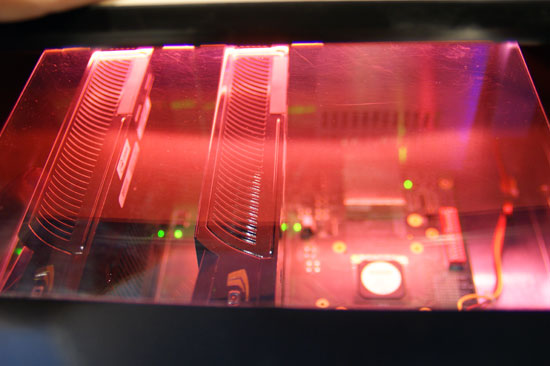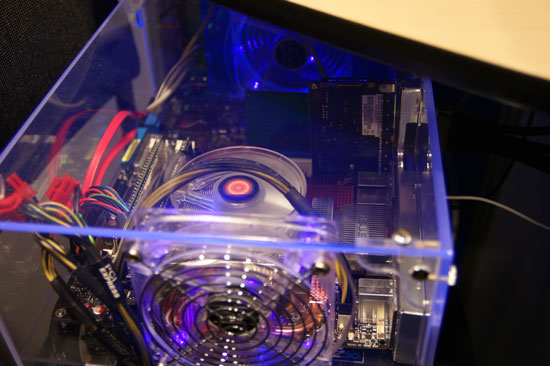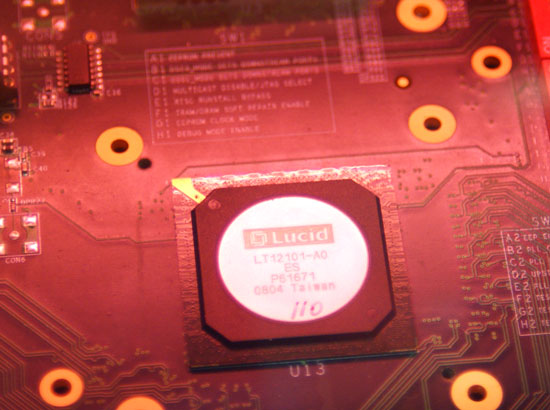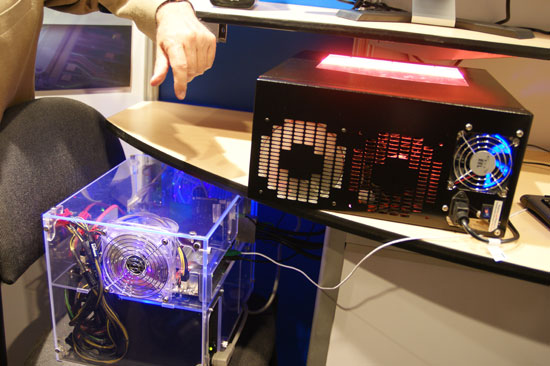Lucid Hydra 100 - Enabling SLI/CrossFire on Any Platform
by Derek Wilson on August 20, 2008 12:00 AM EST- Posted in
- Trade Shows
Well the title is a little misleading. It isn't enabling SLI or CrossFire: it is making them irrelevant and useless by replacing them with a better GPU independent multi-GPU solution. Lucid is a company with lots of funding from Intel, and they are a chip designer that is gearing up to sell hardware that enables truly scalable multi-GPU rendering.

While graphics is completely scalable and there are native solutions to extract near linear performance gains in every case, NVIDIA and AMD have opted not to go down this path yet. It is quite difficult, as it involves the sharing of resources and more fine grained distribution of the workload. SLI and CrossFire are bandaid solutions that don't scale well past 3 GPUs. Their very course grained load balancing and the tricks that must be done to handle certain rendering techniques really hobbles the inherent parallelism of graphics.

Lucid, with their Hydra Engine and the Hydra 100 chip, are going in a different direction. With a background in large data set analysis, these guy are capable of intercepting the DirectX or OpenGL command stream before it hits the GPU, analyzing the data, and dividing up scene at an object level. Rather than rendering alternating frames, or screens split on the horizontal, this part is capable of load balancing things like groups of triangles that are associated with a single group of textures and sending these tasks to whatever GPU it makes the most sense to render on. The scene is composited after all GPUs finish rendering their parts and send the data back to the Lucid chip.

The tasks that they load balance are even dynamically defined, and they haven't gone into a lot of detail with us at this point. But we have another meeting scheduled with them today. So we'll see what happens there.

These guys say they always get near linear scaling regardless of application, and that the scaling is not limited to a number of GPUs. Meaning that 4x GPUs would actually see nearly 4x scaling. Or that 10 GPUs would see 10x scaling. The implications, if this actually works as advertised are insane.

So why is Intel interested in this? Well, they could offer a platform solution through motherboards with this chip on them that delivers better multi-GPU scaling than either NVIDIA or AMD are capable of offering natively on their own platforms. With the issues in getting NVIDIA SLI on Intel systems, this will really be a slap in the face for them.

We will definitely bring you more when we know it. At this point it seems like a great idea, but the theory doesn't always line up with the execution. If they pull of what they say they can it will revolutionize multi-GPU. We'll see what happens.










33 Comments
View All Comments
RedSpectacle - Thursday, April 2, 2009 - link
and the best need only be better than SLI/Crossfire, does this mean we will begin to see major changes in motherboard design? 12 slot 16x or more? Real-time modeling for weather system software in desktop enthusiast platforms? Games that shame Crysis around the corner simply because near linear scaling would mean the end of ceilings? 4 gpus for 60fps @1920x1200, but 10 gpus to unlock 4k resolutution @60fps?Pok3R - Thursday, August 21, 2008 - link
Looks like Intel is decided to finally make a radical change in the hardware-graphics market with Hydra and Larrabee.
Good news for the consumer, bad news for Ati and Nvidia.
What about prices and when is this going to be available? Cant wait!
Darth Pingu - Wednesday, August 20, 2008 - link
Assuming this technology works as advertised it wont be long until ATI and Nvidia either work out liscensing deals or begin work into cloning the technology themselves.If they can liscens it for a decient ammount then it can quite possibly serve to their benefit. They wont have to spend time developing and modifying their drivers for Xfire and SLI then can just spend time making efficient drivers that work.
Game companies will no longer have to develop the game to work with one or the other and ATI/Nvidia no longer have to worry about specific profiles for the games. Who knows this might just be the beginning of something really awesome, Graphics cards that work evenly all around with fewer hastles.
True they dont give us too many hastles now but I for one would welcome a world with no specific game configurations or worrying about driver upgrades potentially breaking older games. Can you imagine it, I can and it makes me happy.
tejas84 - Wednesday, August 20, 2008 - link
This is clearly Intel trying to become a graphics monopoly now. I am sure that AMD and Nvidia will try to break this chip via their drivers in order to retain Crossfire and SLI. Crossfire works great and SLI is pretty good too. I hope this brings AMD and Nvidia closer and hopefully they can report Intel to the European Commission for more anti competitive monopolising behaviour... And no I am not anti Intel as I own a QX9650 and Intel Atom netbooks. In fact I have never owned an AMD chip... This will be a total flop...mark my words. Lucid should concentrate on Intel GPUS such as Larrabee. Also I am really staring to think that Anand is an Intel fanboy...Just my two centsetekberg - Thursday, August 21, 2008 - link
So let me get this straight...You are saying that were Intel to try to compete with nVidia and AMD in the SLI/Crossfire realm, Intel is actually being anti-competitive??
That's rich...
I say "were Intel", because when I read the story it was Lucid's invention, not Intel's.
myocardia - Wednesday, August 20, 2008 - link
Since when did someone bringing you interesting news make them a fanboy? BTW, Anand didn't write this article.;)AggressorPrime - Wednesday, August 20, 2008 - link
Well, it really only threatens nVidia's nForce 200 implementation with the x58 and any chipsets bought over Intel's for SLI/Crossfire purposes. For while directly this chip will replace the nForce 200, other chipsets will still sell if people like how they perform. And you also need to remember that Lucid is not hurting the CPU market, but actually helping it. Anything that makes people more comfortable buying more GPUs is a plus for both AMD and nVidia.AggressorPrime - Wednesday, August 20, 2008 - link
Another question I have is that, if you put one of these on a card that connects to 4 GPUs, can you also have one of these on a motherboard that connects to 4 of such cards, a case in which these Hydra 100's grow off of each other while maintaining linear performance, or can they just connect to GPUs and not other Hydra 100s?siberus - Wednesday, August 20, 2008 - link
Wouldnt nvidia and amd still be able to lock their cards from from working in the drivers?Penti - Wednesday, August 20, 2008 - link
As there is no DX or OGL "command stream" to the graphics cards, it's Lucid Logixs software that intercepts them. I'm still not sure how it distributes the workload though. But i guess that has to be 100% before the drivers of the cards, but it seems kinda odd having it as a PCI-e switch. But i guess it needs the x16 2.0 interface and motherboards don't need any more lanes to deal with. I guess it does some framebuffer magic to combine the results into one image.